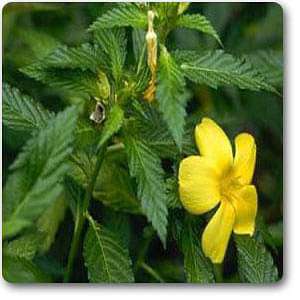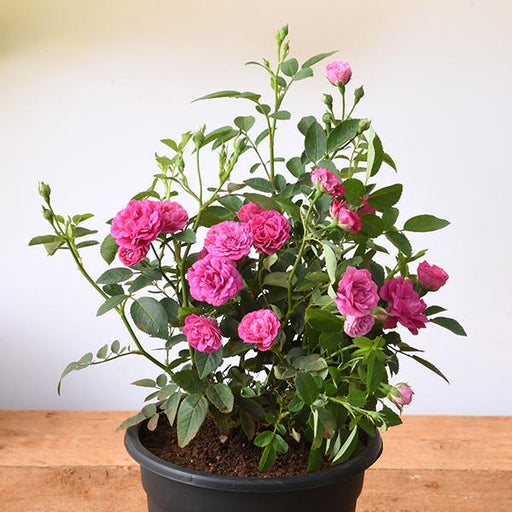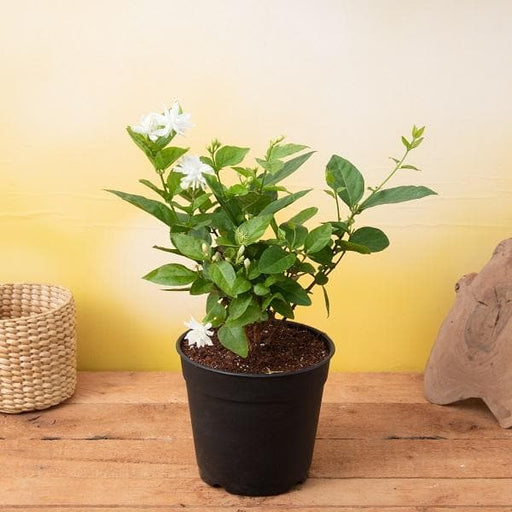
Damiana - Plant
(MRP Inclusive of all taxes)
- Shipping ₹79 for entire order
- Dispatch in 7 days
- Country of origin: India

(MRP Inclusive of all taxes)
 Save 29%
Save 29%
Air Purifier Money Plant with Pot The Air Purifier Money Plant, also known as Pothos or Epipremnum aureum, is a stunning indoor plant that...
View full details
 Save up to 15%
Save up to 15%
Peace Lily, Spathiphyllum - Plant The Peace Lily, scientifically known as Spathiphyllum, is a stunning houseplant celebrated for its elegant white...
View full details
 Save 25%
Save 25%
Jasminum sambac, Mogra, Arabian Jasmine - Plant Jasminum sambac, commonly known as Mogra or Arabian Jasmine, is a fragrant flowering plant...
View full details
 Save 18%
Save 18%
Combo Constituents Includes the Parijat Tree (Night-Flowering Jasmine), a culturally significant plant with fragrant flowers. Description The Pari...
View full details
 Save 25%
Save 25%
Miniature Rose, Button Rose (Any Color) - Plant The Miniature Rose, also known as the Button Rose, is a charming and compact flowering plant that ...
View full details Save 25%
Save 25%
Damascus Rose, Scented Rose (Any Color) - Plant The Damascus Rose, also known as Rosa damascena, is a timeless symbol of beauty and romanc...
View full details
 Save 17%
Save 17%
Beautiful Fragrant Mogra, Arabian Jasmine Plant with Pot The Beautiful Fragrant Mogra, also known as Arabian Jasmine (Jasminum sambac), is...
View full details Save 15%
Save 15%
Pack of Vermicompost and Neem Cake for House Plants Transform your indoor garden with our premium Pack of Vermicompost and Neem Cake, spec...
View full details
Pack of Plant Growth and Flower Boosters Unlock the full potential of your garden with our Pack of Plant Growth and Flower Boosters! This ...
View full details Save 38%
Save 38%
Combo of Jeevamrut and Neem Raksha for Easy Growth and Protection of Houseplants Transform your indoor garden with our exclusive combo of ...
View full details Save 22%
Save 22%
Plant Nutrients Kit (Pack of 16) for a Healthy Garden Transform your garden into a lush paradise with our Plant Nutrients Kit, featuring 1...
View full details Save 16%
Save 16%
Combo of Top Plant Fertilizers Elevate your gardening game with our exclusive Combo of Top Plant Fertilizers, featuring two bags of premiu...
View full details Save 24%
Save 24%
Pack of 4 Additives to Make Soil Healthy and Nutrient Rich Transform your garden into a thriving ecosystem with our Pack of 4 Additives de...
View full details Save 30%
Save 30%
Transform your gardening experience with our premium Combo of Perlite and Vermiculite. This unique blend is designed to enhance soil aeration and ...
View full details Save 27%
Save 27%
Combo of 2 Vermicompost and Cocopeat - Enrich Your Soil Naturally! Transform your garden into a thriving ecosystem with our Combo of 2 Ver...
View full details
 Save 35%
Save 35%
Best 6 Plants for Perfect Indoor Garden Transform your living space into a lush oasis with our curated collection of the Best 6 Plants for a...
View full details
 Save up to 50%
Save up to 50%
Mini Succulent Garden Pack Transform your space with our Mini Succulent Garden Pack, featuring a delightful collection of 4 any variety beautiful s...
View full details
 Save 30%
Save 30%
5 Best Fragrant Plants Transform your garden or indoor space into a fragrant paradise with our curated selection of the 5 Best Fragrant Plants. Th...
View full details
 Save 24%
Save 24%
Set of 2 Bonsai Looking Grafted Adeniums Transform your indoor or outdoor space with our exquisite Set of 2 Bonsai Looking Grafted Adenium...
View full details Save 45%
Save 45%
Top 4 Die Hard Succulents Pack Transform your indoor or outdoor space with our Top 4 Die Hard Succulents Pack, featuring a curated selecti...
View full details
 Save 30%
Save 30%
5 Best Indoor Plants Pack Transform your living space into a lush oasis with our '5 Best Indoor Plants Pack.' This carefully curated collection fe...
View full details
 Save 25%
Save 25%
Set of 4 Evergreen Air Purifier Plant Pack Transform your indoor space into a lush, green oasis with our Set of 4 Evergreen Air Purifier Pla...
View full details| SrNo | Item Name |
|---|---|
| 1 | Damiana - Plant |
Damiana (Turnera diffusa) is a small shrub native to Central and South America, renowned for its aromatic leaves and rich history in traditional medicine. This resilient plant thrives in warm climates and has been used for centuries by indigenous cultures for its potential aphrodisiac properties and mood-enhancing effects. With its vibrant green leaves and delicate yellow flowers, Damiana not only adds beauty to your garden but also offers a plethora of health benefits.
What makes Damiana special is its unique blend of active compounds, including flavonoids, tannins, and essential oils, which contribute to its therapeutic properties. This plant has been celebrated for its ability to support sexual health, alleviate anxiety, and enhance overall well-being. Its rich history as a natural remedy makes it a valuable addition to any herbal collection.
One of Damiana's standout features is its adaptability; it can thrive in various soil types and requires minimal care, making it perfect for both novice and experienced gardeners. Additionally, its leaves can be harvested for teas, tinctures, and extracts, providing a sustainable way to enjoy its benefits.
Damiana is a sustainable plant that can help improve soil health and prevent erosion. Its deep root system stabilizes the soil, making it beneficial for the environment. Additionally, by growing Damiana, you contribute to the preservation of traditional herbal practices and biodiversity.
Ah, the wonders of Damiana! This little plant is like the Swiss Army knife of herbal remedies. From boosting your mood to enhancing your libido, it’s the herbal equivalent of a pep talk from your best friend. Imagine sipping a tea that not only calms your nerves but also spices up your love life. Talk about multitasking! With its rich history in traditional medicine, Damiana has been the go-to for those seeking a natural pick-me-up. So, if you’re feeling a bit down or just want to add some zing to your evenings, Damiana is your trusty sidekick.
a cozy evening, a warm cup of Damiana tea in hand, and the world’s worries melting away. This herbal infusion is not just a drink; it’s an experience! With its earthy flavor and aromatic charm, Damiana tea is like a warm hug for your insides. It’s known for its calming effects, making it the perfect companion for those Netflix binges or quiet reading sessions. Plus, it’s a great conversation starter—“Oh, you’ve never tried Damiana tea? Let me enlighten you!” So brew a cup, sit back, and let the soothing vibes wash over you.
If Damiana were a superhero, its extract would be its secret weapon. This concentrated form packs a punch, delivering all the plant’s benefits in a convenient bottle. Whether you’re looking to enhance your mood or spice things up in the bedroom, Damiana extract is like having a magic potion at your fingertips. Just a few drops can transform your day from drab to fab. Plus, it’s easy to incorporate into your routine—add it to smoothies, teas, or even cocktails. Who knew herbal remedies could be so versatile and fun?
The uses of Damiana are as varied as a buffet table at a family reunion. From traditional medicine to modern wellness trends, this plant has found its way into the hearts (and homes) of many. It’s often used to alleviate stress, boost energy, and even enhance sexual health. Think of it as the herbal equivalent of a life coach, always ready to help you tackle whatever life throws your way. Whether you’re looking to unwind after a long day or ignite some passion, Damiana has got your back.
Now, before you dive headfirst into the world of Damiana, let’s chat about side effects. Like that friend who always has a wild story, Damiana can have its quirks. While it’s generally safe for most, some might experience mild stomach upset or headaches. It’s like a rollercoaster ride—thrilling but with a few unexpected twists. Always consult with a healthcare professional before embarking on your Damiana adventure, especially if you’re pregnant or on medication. Better safe than sorry, right?
For those who prefer their herbal remedies in pill form, Damiana capsules are here to save the day! These little wonders offer all the benefits of the plant without the fuss of brewing tea or mixing extracts. Just pop a capsule, and you’re good to go! It’s like having a pocket-sized herbal ally ready to support your wellness journey. Perfect for busy bees who want to keep their health game strong without sacrificing convenience. Who knew being healthy could be so easy?
Let’s talk about the spicy side of Damiana—its reputation as a libido booster! This plant has been celebrated for centuries as an aphrodisiac, and for good reason. It’s like the herbal equivalent of a romantic dinner date, setting the mood and igniting passion. Whether you’re looking to rekindle the flames or simply add some excitement to your love life, Damiana is the secret ingredient you didn’t know you needed. So, if you’re feeling a little lackluster in the romance department, Damiana might just be your new best friend.
In a world full of stress, Damiana steps in like a calming breeze on a hot summer day. Known for its soothing properties, this plant can help ease anxiety and promote relaxation. It’s like having a personal cheerleader, encouraging you to take a deep breath and let go of your worries. Whether you’re facing a big presentation or just the daily grind, a little Damiana can go a long way in helping you find your zen. So, why not give it a try and see if it helps you chill out?
Who knew that a little plant could be your ally in the battle of the bulge? Damiana has been linked to weight loss benefits, making it a popular choice for those looking to shed a few pounds. It’s believed to help curb appetite and boost metabolism, which is like having a personal trainer in your pantry. Pair it with a balanced diet and exercise, and you might just find yourself on the path to your fitness goals. So, if you’re looking for a natural boost, Damiana could be your new workout buddy.
Step back in time and discover how Damiana has been a staple in traditional medicine for centuries. Used by indigenous cultures for its healing properties, this plant has a rich history that’s as fascinating as it is beneficial. From treating ailments to enhancing overall well-being, Damiana has earned its place in the herbal hall of fame. It’s like the wise elder of the plant world, offering knowledge and support to those who seek it. So, if you’re curious about herbal traditions, Damiana is a must-know!
Ready to become a plant parent? Growing Damiana is easier than you might think! This resilient little plant thrives in warm climates and can be grown indoors or outdoors. With a little sunlight and care, you’ll have your very own supply of this magical herb at your fingertips. Imagine the satisfaction of brewing your own Damiana tea or crafting your own extracts. It’s like having a mini herbal garden right in your home. So grab your gardening gloves and get ready to nurture this delightful plant!
Damiana is a delightful little shrub native to Mexico and Central America, known for its aromatic leaves and potential aphrodisiac properties. Think of it as nature's love potion, often brewed into teas or used in herbal remedies. It's like a botanical wingman, ready to spice up your life!
Damiana is packed with benefits! It’s said to boost mood, enhance libido, and even support digestive health. Imagine it as your personal cheerleader, encouraging you to feel good and enjoy life. Just remember, while it’s a great herbal ally, it’s not a substitute for a balanced lifestyle!
Using Damiana is as easy as pie! You can brew it into a tea, toss it into smoothies, or even use it in tinctures. Just remember, moderation is key—too much of a good thing can turn your herbal adventure into a wild ride. Sip wisely!
Generally, yes! Damiana is considered safe for most people when used in moderation. However, like that mysterious friend who shows up uninvited, it can cause side effects in some. Always consult a healthcare professional if you're unsure, especially if you're pregnant or on medication!
Some folks swear by Damiana for easing anxiety, claiming it helps them chill out like a sloth on a Sunday. While it may promote relaxation, it’s not a magic wand. Pair it with mindfulness and self-care for the best results, and you might just find your zen!
You can find Damiana at health food stores, herbal shops, or online retailers. Just make sure you’re getting the good stuff—quality matters! Think of it as shopping for a fine wine; you want the best to enjoy its full potential. Cheers to that!
Damiana has a unique flavor profile—earthy with a hint of sweetness, like a cozy hug from nature. Some describe it as slightly herbal with a touch of floral notes. Brew it into tea, and you might just find yourself sipping on a cup of tranquility!
Absolutely! Damiana can add a unique twist to your culinary creations. Sprinkle it into baked goods, blend it into smoothies, or infuse it in oils. Just remember, a little goes a long way—too much might turn your dish into a botanical experiment gone awry!
Most places consider Damiana legal, but always check local laws before you dive in. It’s like trying to sneak a pet into a no-pets-allowed hotel—best to know the rules first! Stay informed, and you’ll be enjoying your herbal escapades without a hitch.
While Damiana is generally safe, some may experience mild side effects like headaches or digestive upset. It’s like that friend who occasionally overstays their welcome—annoying but manageable. If you notice any adverse reactions, it’s best to cut back or consult a healthcare professional.
Yes, Damiana can interact with certain medications, especially those affecting the liver or mood. It’s like mixing oil and water—best to keep them apart! Always consult your doctor before adding it to your herbal repertoire, especially if you’re on medication. Better safe than sorry!